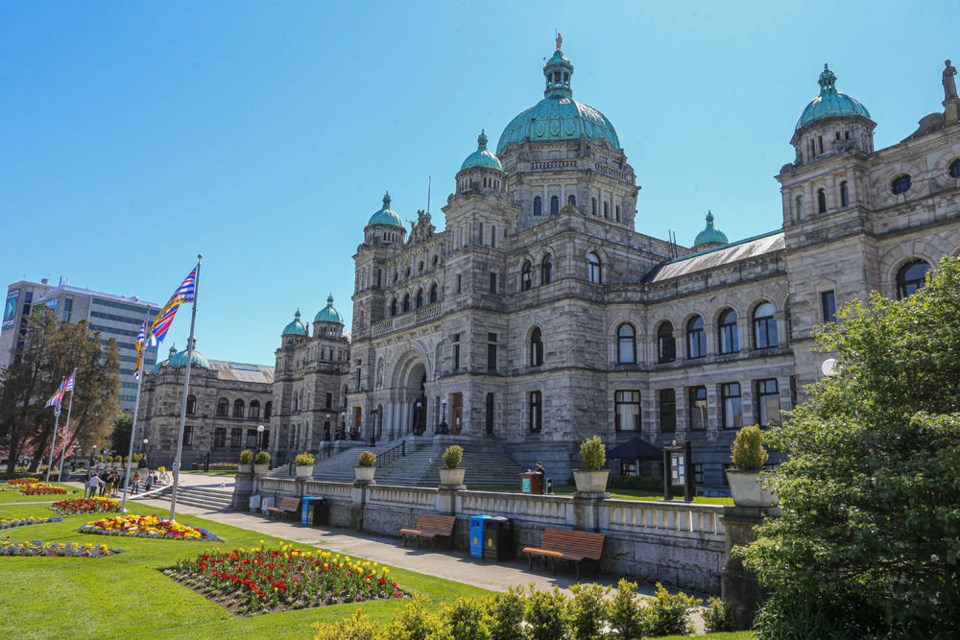You know that part of the movie where the hot air balloon is going down, so the passengers desperately start hucking heavy stuff out of the basket to keep it aloft?
It works, except when the balloon finally does land safely, it’s without the water, wine and cans of baked beans they were counting on to keep them alive.
Which is the image that popped to mind while poring over the mind-numbing numbers in the new provincial budget revealed Tuesday.
Stuff like this: “B.C.’s taxpayer-supported debt is projected to be $71.6 billion at the end of fiscal years 2021-22, $82.8 billion at the end of 2022-23, and $92.7 billion at the end of 2023-24.”
That’s it? A measly $92.7 billion? Jeez, you couldn’t buy a Gordon Head bungalow for $92.7 billion. If you want to see real debt, compare B.C. to the federal government, whose Monday budget will push the national IOU to over $1 trillion. That’s with a T, as in Trudeau.
Good lord, it’s hard to wrap our heads around sums this large. For those of us who can’t do our own income tax without needing to lie down for a nap afterward, the figures are just too great to comprehend.
Not that we’re complaining about the pandemic spending, because who’s going to worry about the baked beans when the balloon is plunging into the volcano?
Massive deficits were a given, given the amount of government spending needed to mitigate the crisis. Still, we have to wonder how we (or, more likely, our children) will ever catch up.
The budget documents attempt to be reassuring, talking about the debt-to-GDP ratio staying under 30 per cent and B.C. benefiting from low lending rates because of its excellent credit rating. “As a result, the province’s debt remains affordable.”
Yet those same documents indicate the economic predictions are based on not just science, but prayer. For one thing, they assume vaccines will work and the world will return to some sort of normalcy in 2022.
Assumptions like that are why we get passages like this: “Given the unprecedented level of uncertainty resulting from the ongoing impacts of the pandemic, it is too early to forecast a specific timeline …. However, preliminary analysis indicates a return to balanced budgets within a range of seven to nine years.”
So, it’s no surprise that Tuesday’s budget, even while including $8.7 billion in new spending over three years, plus $4.6 billion in pandemic-related contingency funds, didn’t include the array of shiny trinkets you see when politicians aim to dazzle the average voter.
Spending was targeted to those most in need — $265 million spent on temporary housing, meals and supports for vulnerable people, for example, and $120 million for the tourism and arts sectors.
That left precious little new for those looking for individual or local benefit. The main bits — the ICBC rebates you just got in the mail, the $500-$1,000 COVID-recovery grant you already spent — were previously announced.
There were only a few stray minor measures to reveal: There’s no more PST on electric bikes as of today, kids 12 and under will ride the bus for free, and the homeowner grant threshold bumps up to $1.625 million from $1.525 million (see: Gordon Head bungalow).
Likewise, the capital spending plan didn’t tell us anything we didn’t already know, though the numbers were still mind-boggling. Duncan will see an $887-million replacement for Cowichan District Hospital open in 2026 and an $82-million Cowichan Secondary 2.0 in 2024.
The Vic High rebuild is costed at $80 million, while the Sooke district will see $89 million spent on the 500-student Pexsisen Elementary and the 700-student Centre Mountain Lellum Middle School.
There’s $45 million for new elementary and secondary schools in Ucluelet and $27 million for the new National Centre for Indigenous Laws at UVic.
The cost of the road construction currently bedeviling Sooke commuters has fallen from $86 million to $77 million, but the new replacement prison at Nanaimo is now pegged at $167 million, up from $157 million.
Colwood will get a big new collections and research building for the Royal B.C. Museum. A flyover on the Patricia Bay Highway will eliminate that sphincter-tightening left-hand turn onto Keating Cross Road (no magic fix for the Malahat, though).
Oh, and don’t forget the social housing projects.
The bottom line? Just give us our shots ASAP and tell us when we can go listen to a band in a crowded bar, and we’ll worry about the bill tomorrow.



